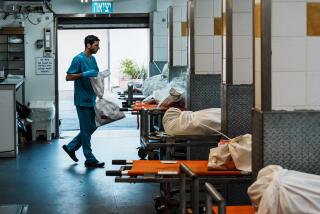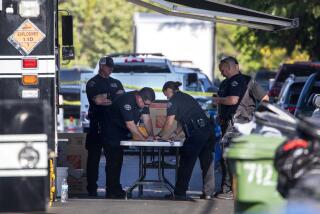Investigators Work âOne Shovel at a Timeâ
NAIROBI, Kenya â When looking for clues about a big bomb blast, the rule of thumb is think small. Very small.
âWe are taking it one shovel at a time,â said an FBI investigator, skirting between the U.S. Embassy here and a mound of debris across the street. âEverything has to be scrutinized.â
The U.S. investigation into the bomb blast in Kenya, in its first day of hands-on work Monday, is being played out in minute detail on the vast grounds of the Kenyan national railway headquarters. Evidence as small as a thumbnail is being delicately extracted from a two-story high mountain of rubble--piece by piece.
The stately colonial-era railway building lies across a broad boulevard from the embassy, its grassy parkway shaded by singed jacaranda trees and its terra cotta roof blown to bits by Fridayâs explosion. U.S. investigators, backed by a handful of Kenyan bomb experts, are within earshot of the grueling search for bodies on the same battered street.
âThe Americans are doing what they need to do, and we are doing what we need to do,â said David Gitunga, a somber Red Cross volunteer, watching a mangled body being pulled from the collapsed Ufundi Cooperative building, the epicenter of last weekâs terrorist blast.
The FBIâs open-air laboratory, shielded only by occasional sheets of canvas draped over a spiked fence, is hardly the top-secret, high-technology operation one might expect. Some investigators used broken sticks to sift through lumps of dirt unearthed by the explosion. Others sat in the asphalt parking lot. Those who needed a desk used three rickety wooden tables and an assortment of wobbly chairs grabbed from a nearby building.
But as one newly arrived U.S. soldier remarked, newcomers here are learning that working a disaster in a poor and developing country is nothing like back home. âThis isnât Ohio,â the soldier said.
The biggest problem for the FBI is the condition of the evidence itself. Though no one will say so officially, it is easy to see that it is an investigatorâs worst nightmare.
Strewn across an entire block, it has been trampled over and over again by rescue workers, volunteers and gawkers. Heavy trucks have flattened everything from car parts to crumbling concrete. Small, mostly unrecognizable items have even been pocketed as souvenirs.
âThere are conflicting priorities,â a U.S. official said of the blast scene. âIf you are trying to get the bodies out, you are not going to have a pristine site.â
Until the FBI arrived, Kenyan military authorities said, no one even thought of the debris as evidence. It was just stuff getting in the way of saving lives, they said.
âWeâve now been told by the Americans to go around the entire vicinity and pick up any pieces of metal that have flown,â said Maj. Gen. George Agoi, commander of the Kenyan army troops deployed at the bomb site. âThey told us that would be of great evidence. The operation is now entirely theirs, so we are doing what they ask.â
At the insistence of the Americans, access to the blast area also was being controlled more carefully Monday, though additional police barricades were still more a point for discussion than a reality.
The frustration of investigative teams was almost palpable late in the afternoon when Kenyan police were persuaded by Nairobi University students to allow a peace march on a stretch of the boulevard sandwiched between the railway building and the U.S. Embassy.
An FBI official, perched atop a front-end loader hauling debris for examination at the railway grounds, stared in disbelief as several hundred students swarmed past the yellow-tape police line. âThey promised to stay on the road and not go near the embassy,â a police officer explained, paying no heed to the carpet of metal, concrete and wood being trampled underfoot.
Privacy also is something the FBI investigators--who are normally obsessively secretive--are finding in short supply.
Kenyan office employees, turned away from shaky downtown high-rises, passed their day peering over the railway fence and gossiping in Swahili about the curious undertaking. Some foreign television crews, looking for a fresh backdrop for newscasts, also shifted their lenses from the ruined embassy building to the bustling FBI enclave.
Stone-faced investigators did their best to ignore the commotion, much like a caged animal refusing to acknowledge visitors at the zoo. âEach investigation is different,â one of them offered during a foray out of the examination area.
While at work, the dozens of investigators, dressed in blue jeans and baseball caps and looking very much like college fraternity brothers, spoke only to announce a potentially important find or to request the help of a colleague.
Not an inch of rubble went unexamined.
âThere is a gear right there,â said one man in his 30s, his voice muffled by a protective mask. He pointed to a tiny piece of black metal buried in a shovel of dirt.
âIf it is a car part, stick it over there,â replied a fellow investigator, pointing to a growing pile of wreckage a few yards away.
âIâve got the tailgate from a truck!â came the excited voice of another investigator moments later, yanking a sheet of twisted black metal from beneath a slab of concrete.
Small fragments of evidence were separated into plastic buckets. Concrete chunks with possible chemical traces from a bomb were set aside. Large hulks of burned-out vehicles were laid out in the parking lot.
Though acknowledging that much of the evidence may have been lost or contaminated in the three days after the blast, U.S. officials said they can afford to leave no stone unturned.
âYou never know where something might turn up,â the FBI investigator said. âThatâs why we do it shovel by shovel.â
* STRUGGLE WITH LOSS: Both Kenyans and Americans mourn victims, including the U.S. consul general. A16,17
More to Read
Sign up for Essential California
The most important California stories and recommendations in your inbox every morning.
You may occasionally receive promotional content from the Los Angeles Times.









